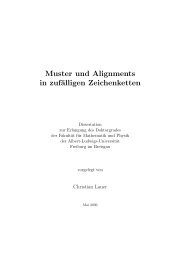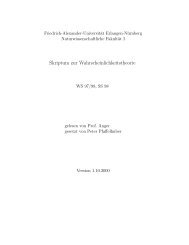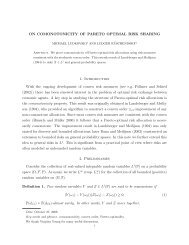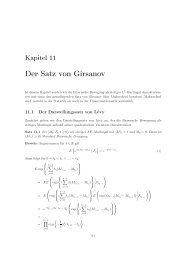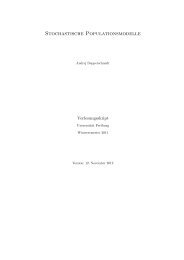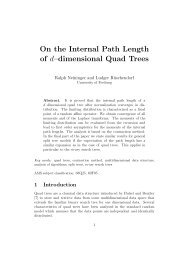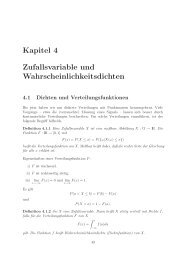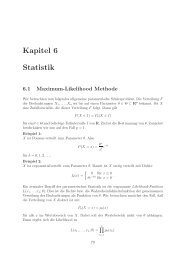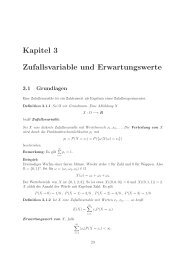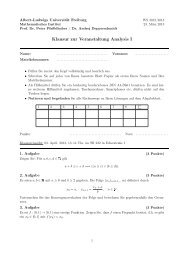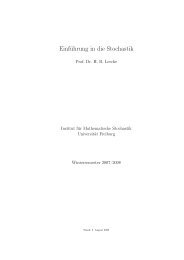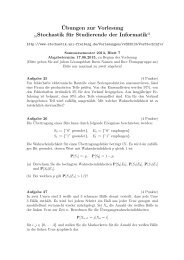Analysis of Markov chain algorithms on spanning trees, rooted ...
Analysis of Markov chain algorithms on spanning trees, rooted ...
Analysis of Markov chain algorithms on spanning trees, rooted ...
Create successful ePaper yourself
Turn your PDF publications into a flip-book with our unique Google optimized e-Paper software.
J. Fehrenbach and L. Rüschendorf 19<br />
The max expressi<strong>on</strong> can be estimated using Theorem 4.2. For a transisti<strong>on</strong><br />
(B, C) <str<strong>on</strong>g>of</str<strong>on</strong>g> M s (G) let e be the unique edge in B\C. In any can<strong>on</strong>ical path<br />
γ<br />
XY<br />
∈ P(B, C) the transiti<strong>on</strong> (B, C) is coded by some ¯B ∈ Ω. By Theorem 4.2<br />
there exists exactly <strong>on</strong>e can<strong>on</strong>ical path in Γ G with these properties. Since this<br />
path not necessarily c<strong>on</strong>tains (B, C) we c<strong>on</strong>clude that |P(B, C)| ≤ |Ω|. This<br />
implies<br />
ϱ(Γ G ) ≤ 2n2 m<br />
|Ω|<br />
With |Ω| ≤ m n we thus obtain<br />
· |Ω| = 2n 2 m. (4.4)<br />
τ s (ε) ≤ 2n 2 m(n log m + log ε −1 ). (4.5)<br />
5 Forests with roots<br />
In this secti<strong>on</strong> we apply the multi-commodity flows resp. can<strong>on</strong>ical paths to<br />
the analysis <str<strong>on</strong>g>of</str<strong>on</strong>g> the mixing time <str<strong>on</strong>g>of</str<strong>on</strong>g> some <str<strong>on</strong>g>Markov</str<strong>on</strong>g> <str<strong>on</strong>g>chain</str<strong>on</strong>g>s <strong>on</strong> forests. The <str<strong>on</strong>g>Markov</str<strong>on</strong>g><br />
<str<strong>on</strong>g>chain</str<strong>on</strong>g> M s introduced in secti<strong>on</strong>s 2, 3 <strong>on</strong> the set <str<strong>on</strong>g>of</str<strong>on</strong>g> <strong>spanning</strong> <strong>trees</strong> <strong>on</strong>ly uses<br />
exchanges <str<strong>on</strong>g>of</str<strong>on</strong>g> two edges. These transiti<strong>on</strong>s can also be used <strong>on</strong> the class <str<strong>on</strong>g>of</str<strong>on</strong>g><br />
forests i.e. circle free subgraphs <str<strong>on</strong>g>of</str<strong>on</strong>g> G and the corresp<strong>on</strong>ding <str<strong>on</strong>g>Markov</str<strong>on</strong>g> <str<strong>on</strong>g>chain</str<strong>on</strong>g><br />
has an stati<strong>on</strong>ary distributi<strong>on</strong> the uniform distributi<strong>on</strong>. But s<str<strong>on</strong>g>of</str<strong>on</strong>g>ar no efficient<br />
bounds for the mixing time <str<strong>on</strong>g>of</str<strong>on</strong>g> this or related <str<strong>on</strong>g>Markov</str<strong>on</strong>g> <str<strong>on</strong>g>chain</str<strong>on</strong>g>s are known and also<br />
no randomized approximati<strong>on</strong> schemes for the number <str<strong>on</strong>g>of</str<strong>on</strong>g> forests are known (see<br />
Welsh and Merino (2000)). It seems that also the can<strong>on</strong>ical paths <str<strong>on</strong>g>of</str<strong>on</strong>g> secti<strong>on</strong> 4<br />
transfered to this problem do not lead to a polynomial bound for the mixing<br />
time. In the following we c<strong>on</strong>sider the modified class <str<strong>on</strong>g>of</str<strong>on</strong>g> forests with roots F r (G)<br />
and show that for this modified space Ω = F r (G) we obtain rapid mixing<br />
results for various <str<strong>on</strong>g>Markov</str<strong>on</strong>g> <str<strong>on</strong>g>chain</str<strong>on</strong>g>s by means <str<strong>on</strong>g>of</str<strong>on</strong>g> the corresp<strong>on</strong>ding can<strong>on</strong>ical<br />
paths c<strong>on</strong>structed for the class <str<strong>on</strong>g>of</str<strong>on</strong>g> <strong>spanning</strong> <strong>trees</strong>.<br />
Definiti<strong>on</strong> 5.1 (Forests with roots) Let G=(V, E) be an undirected graph.<br />
A pair X := (R X , E X ) with R X ⊂ V, E X ⊂ E is called forest with roots if<br />
• the subgraph (V, E X ) <str<strong>on</strong>g>of</str<strong>on</strong>g> G c<strong>on</strong>tains no circle<br />
• any c<strong>on</strong>nected comp<strong>on</strong>ent Z <str<strong>on</strong>g>of</str<strong>on</strong>g> (V, E X ) has exactly <strong>on</strong>e node in R X , which<br />
we call the root <str<strong>on</strong>g>of</str<strong>on</strong>g> Z.<br />
F r (G) denotes the set <str<strong>on</strong>g>of</str<strong>on</strong>g> all forests with roots.<br />
Counting forests with roots corresp<strong>on</strong>ds to counting forests X with c<strong>on</strong>nected<br />
comp<strong>on</strong>ents Z 1 , . . . , Z d which are weighted by the number <str<strong>on</strong>g>of</str<strong>on</strong>g> possibilities<br />
to choose a root system i.e. by ∏ d<br />
i=1 |Z i|(n−|X|). The class F r (G) <str<strong>on</strong>g>of</str<strong>on</strong>g> forests<br />
with roots can be identified with the class <str<strong>on</strong>g>of</str<strong>on</strong>g> <strong>spanning</strong> <strong>trees</strong> <str<strong>on</strong>g>of</str<strong>on</strong>g> an extended<br />
graph G ′ .<br />
Lemma 5.2 For any undirected graph G = (V, E) there exists a graph G ′ =<br />
(V ′ , E ′ ), such that there exists a bijecti<strong>on</strong> Sp : F r (G)) −→ ST (G ′ ).



